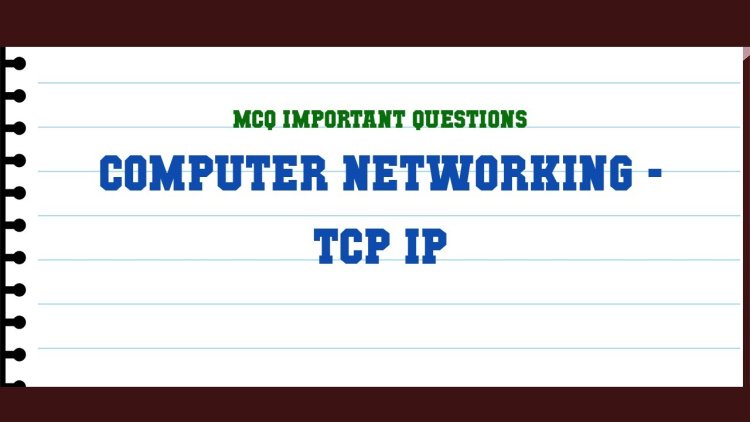TCP/IP Layers MCQ's - Computer Network MCQ's

[MCQ’s] Computer Network-Module-1
1.How many layers are present in the Internet protocol stack (TCP/IP model)?
a) 5
b) 7
c) 6
d) 10
Answer: a
2.The number of layers in ISO OSI reference model is __________
a) 5
b) 7
c) 6
d) 10
Answer: b
3. Which of the following layers is an addition to OSI model when compared with TCP IP model?
a) Application layer b) Presentation layer c) Session layer d) Session and Presentation layer
Answer: d
3. Application layer is implemented in ____________
a) End system b) NIC c) Ethernet d) Packet transport
Answer: a
4.Transport layer is implemented in ______________
a) End system b) NIC c) Ethernet d) Signal transmission
Answer: a
5.The functionalities of the presentation layer include ____________
a) Data compression b) Data encryption c) Data description d) All of the mentioned
Answer: d
6.Delimiting and synchronization of data exchange is provided by __________
a) Application layer b) Session layer c) Transport layer d) Link layer
Answer: b
7. In OSI model, when data is sent from device A to device B, the 5th layer to receive data at B is _________
a) Application layer b) Transport layer c) Link layer d) Session layer
Answer: d
8. In TCP IP Model, when data is sent from device A to device B, the 5th layer to receive data at B is ____________
a) Application layer b) Transport layer c) Link layer d) Session layer
Answer: a
8. In the OSI model, as a data packet moves from the lower to the upper layers, headers are _______
a) Added b) Removed c) Rearranged d) Randomized
Answer: b
9. Which of the following statements can be associated with OSI model?
a) A structured way to discuss and easier update system components b) One layer may duplicate lower layer functionality c) Functionality at one layer no way requires information from another layer d) It is an application-specific network model
Answer: c
10. OSI stands for __________
a) open system interconnection b) operating system interface c) optical service implementation d) open service Internet
Answer: a
11.The number of layers in ISO OSI reference model is __________
a) 4
b) 5
c) 6
d) 7
Answer: d
12. TCP/IP model does not have ______ layer but OSI model have this layer.
a) session layer b) transport layer c) application layer d) network layer
Answer: a
13. Which layer is used to link the network support layers and user support layers?
a) session layer b) data link layer c) transport layer d) network layer
Answer: c
14. Which address is used on the internet for employing the TCP/IP protocols?
a) physical address and logical address b) port address c) specific address d) all of the mentioned
Answer: d
15. TCP/IP model was developed _____ the OSI model.
a) prior to b) after c) simultaneous to d) with no link to
Answer: a
16.Which layer is responsible for process to process delivery in a general network model?
a) network layer b) transport layer c) session layer d) data link layer
Answer: b
17.Which address is used to identify a process on a host by the transport layer?
a) physical address b) logical address c) port address d) specific address
Answer: c
18. Which layer provides the services to user?
a) application layer b) session layer c) presentation layer d) the physical layer
Answer: a
19. Transmission data rate is decided by ____________
a) network layer b) physical layer c) data link layer d) transport layer
Answer: b
20.Physical or logical arrangement of network is __________
a) Topology b) Routing c) Networking d) Control
Answer: a
21. Which network topology requires a central controller or hub?
a) Star b) Mesh c) Ring d) Bus
Answer: a
22._______ topology requires a multipoint connection.
a) Star b) Mesh c) Ring d) Bus
Answer: d
23. Data communication system spanning states, countries, or the whole world is ________
a) LAN b) WAN c) MAN d) PAN
Answer: b
24. Data communication system within a building or campus is________
a) LAN b) WAN c) MAN d) PAN
Answer: a
25. WAN stands for __________
a) World area network b) Wide area network c) Web area network d) Web access network
Answer: b
26.In TDM, slots are further divided into __________
a) Seconds b) Frames c) Packets d) Bits
Answer: b
27. _____ is the multiplexing technique that shifts each signal to a different carrier frequency.
a) FDM b) TDM c) Both FDM & TDM d) PDM
Answer: a
28. The sharing of a medium and its link by two or more devices is called _________
a) Fully duplexing b) Multiplexing c) Micropleixng d) Duplexing
Answer: b
29. Multiplexing is used in _______
a) Packet switching b) Circuit switching c) Data switching d) Packet & Circuit switching
Answer: b
30.Which multiplexing technique used to transmit digital signals?
a) FDM b) TDM c) WDM d) FDM & WDM
Answer: b
31. If there are n signal sources of same data rate, then the TDM link has _______ slots.
a) n b) n/2 c) n*2 d) 2n
Answer: a
32.If link transmits 4000frames per second, and each slot has 8 bits, the transmission rate of circuit this TDM is _________
a) 32kbps b) 500bps c) 500kbps d) 32bps
Answer: a
33.The state when dedicated signals are idle are called __________
a) Death period b) Poison period c) Silent period d) Stop period
Answer: c
34.Multiplexing provides _________
a) Efficiency b) Privacy c) Anti jamming d) Both Efficiency & Privacy
Answer: d
35.In TDM, the transmission rate of a multiplexed path is always _______ the sum of the transmission rates of the signal sources.
a) Greater than b) Lesser than c) Equal to d) Equal to or greater than
Answer: a
36.In TDM, slots are further divided into _________
a) Seconds b) Frames c) Packets d) Bits
Answer: b







